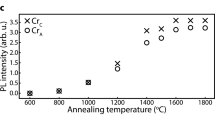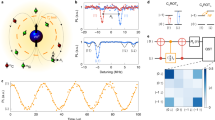Abstract
Spins in solids are cornerstone elements of quantum spintronics1. Leading contenders such as defects in diamond2,3,4,5 or individual phosphorus dopants in silicon6 have shown spectacular progress, but either lack established nanotechnology or an efficient spin/photon interface. Silicon carbide (SiC) combines the strength of both systems5: it has a large bandgap with deep defects7,8,9 and benefits from mature fabrication techniques10,11,12. Here, we report the characterization of photoluminescence and optical spin polarization from single silicon vacancies in SiC, and demonstrate that single spins can be addressed at room temperature. We show coherent control of a single defect spin and find long spin coherence times under ambient conditions. Our study provides evidence that SiC is a promising system for atomic-scale spintronics and quantum technology.
This is a preview of subscription content, access via your institution
Access options
Subscribe to this journal
Receive 12 print issues and online access
$259.00 per year
only $21.58 per issue
Buy this article
- Purchase on Springer Link
- Instant access to full article PDF
Prices may be subject to local taxes which are calculated during checkout




Similar content being viewed by others
References
Morton, J. J. L. & Lovett, B. W. Hybrid solid-state qubits: The powerful role of electron spins. Annu. Rev. Condens. Matter Phys. 2, 189–212 (2011).
Awschalom, D. D., Bassett, L. C., Dzurak, A. S., Hu, E. L. & Petta, J. R. Quantum spintronics: Engineering and manipulating atom-like spins in semiconductors. Science 339, 1174–1179 (2013).
Balasubramanian, G. et al. Ultralong spin coherence time in isotopically engineered diamond. Nature Mater. 8, 383–387 (2009).
Lee, S-Y. et al. Readout and control of a single nuclear spin with a meta-stable electron spin ancilla. Nature Nanotech. 8, 487–492 (2013).
Weber, J. R. et al. Quantum computing with defects. Proc. Natl Acad. Sci. USA 107, 8513–8518 (2010).
Morello, A. et al. Single-shot readout of an electron spin in silicon. Nature 467, 687–691 (2010).
Janzén, E. et al. Defects Microelectronic Materials and Devices 615–669 (CRC Press, 2008).
Janzén, E. et al. The silicon vacancy in SiC. Physica B 404, 4354–4358 (2009).
Koehl, W. F., Buckley, B. B., Heremans, F. J., Calusine, G. & Awschalom, D. D. Room temperature coherent control of defect spin qubits in silicon carbide. Nature 479, 84–87 (2011).
Aichinger, T., Lenahan, P. M., Tuttle, B. R. & Peters, D. A nitrogen-related deep level defect in ion implanted 4H-SiC pn junctions—A spin dependent recombination study. Appl. Phys. Lett. 100, 112113–112114 (2012).
Maboudian, R., Carraro, C., Senesky, D. G. & Roper, C. S. Advances in silicon carbide science and technology at the micro- and nanoscales. J. Vac. Sci. Technol. A 31, 50805–50818 (2013).
Song, B-S., Yamada, S., Asano, T. & Noda, S. Demonstration of two-dimensional photonic crystals based on silicon carbide. Opt. Express 19, 11084–11089 (2011).
Matsunami, H. Current SiC technology for power electronic devices beyond Si. Microelectron. Eng. 83, 2–4 (2006).
Soltamov, V. A., Soltamova, A. A., Baranov, P. G. & Proskuryakov, I. I. Room temperature coherent spin alignment of silicon vacancies in 4H- and 6H-SiC. Phys. Rev. Lett. 108, 226402 (2012).
Gaebel, T. et al. Room-temperature coherent coupling of single spins in diamond. Nature Phys. 2, 408–413 (2006).
Baranov, P. G. et al. Silicon vacancy in SiC as a promising quantum system for single-defect and single-photon spectroscopy. Phys. Rev. B 83, 125203 (2011).
Falk, A. L. et al. Polytype control of spin qubits in silicon carbide. Nature Commun. 4, 1819 (2013).
Falk, A. L. et al. Electrically and mechanically tunable electron spins in silicon carbide color centers. Phys. Rev. Lett. 112, 187601 (2014).
Yang, Y. T. et al. Monocrystalline silicon carbide nanoelectromechanical systems. Appl. Phys. Lett. 78, 162–164 (2001).
Klimov, P. V., Falk, A. L., Buckley, B. B. & Awschalom, D. D. Electrically driven spin resonance in silicon carbide color centers. Phys. Rev. Lett. 112, 87601 (2014).
Castelletto, S. et al. A silicon carbide room-temperature single-photon source. Nature Mater. 13, 151–156 (2014).
Mizuochi, N. et al. Continuous-wave and pulsed EPR study of the negatively charged silicon vacancy with S = 3/2 and C3v symmetry in n-type 4H-SiC. Phys. Rev. B 66, 235202 (2002).
Kraus, H. et al. Room-temperature quantum microwave emitters based on spin defects in silicon carbide. Nature Phys. 10, 157–162 (2014).
Hain, T. C. et al. Excitation and recombination dynamics of vacancy-related spin centers in silicon carbide. J. Appl. Phys. 115, 133508 (2014).
Childress, L. et al. Coherent dynamics of coupled electron and nuclear spin qubits in diamond. Science 314, 281–285 (2006).
De Sousa, R. & Das Sarma, S. Theory of nuclear-induced spectral diffusion: Spin decoherence of phosphorus donors in Si and GaAs quantum dots. Phys. Rev. B 68, 115322 (2003).
Yang, L-P. et al. Electron spin decoherence in silicon carbide nuclear spin bath. Preprint at http://arxiv.org/abs/1409.4646 (2014)
Witzel, W. M., Carroll, M. S., Morello, A., Cywiński, Ł & Das Sarma, S. Electron spin decoherence in isotope-enriched silicon. Phys. Rev. Lett. 105, 187602 (2010).
Ivanov, I. G. et al. High-resolution Raman and luminescence spectroscopy of isotope-pure 28Si12C, natural and 13C-enriched 4H-SiC. Mater. Sci. Forum 778–780, 471–474 (2014).
Hanson, R., Dobrovitski, V. V., Feiguin, A. E., Gywat, O. & Awschalom, D. D. Coherent dynamics of a single spin interacting with an adjustable spin bath. Science 320, 352–355 (2008).
Jenny, J. R. et al. Development of large diameter high-purity semi-insulating 4H-SiC wafers for microwave devices. Mater. Sci. Forum 457–460, 35–40 (2004).
Son, N. T., Carlsson, P., ul Hassan, J., Magnusson, B. & Janzén, E. Defects and carrier compensation in semi-insulating 4H-SiC substrates. Phys. Rev. B 75, 155204 (2007).
De Lange, G., Wang, Z. H., Ristè, D., Dobrovitski, V. V. & Hanson, R. Universal dynamical decoupling of a single solid-state spin from a spin bath. Science 330, 60–63 (2010).
Kimoto, T., Nakazawa, S., Hashimoto, K. & Matsunami, H. Reduction of doping and trap concentrations in 4H-SiC epitaxial layers grown by chemical vapor deposition. Appl. Phys. Lett. 79, 2761–2763 (2001).
Tsuchida, H. et al. Characterization of 4H-SiC epilayers grown at a high deposition rate. 353–356, 131–134 (2001).
Christle, D. J. et al. Isolated electron spins in silicon carbide with millisecond coherence times. Nature Mater. (2014) 10.1038/nmat4144
Riedel, D. et al. Resonant addressing and manipulation of silicon vacancy qubits in silicon carbide. Phys. Rev. Lett. 109, 226402 (2012).
Acknowledgements
We acknowledge support by the EU via SQUTEC, SIQS and QINVC; DARPA via QuASAR; DFG via SPP 1601 and Forschergruppe FOR1493 and the Max Planck Society. A.G. acknowledges support from the Lendület programme of the Hungarian Academy of Sciences, and Hungarian OTKA grant nos K101819 and K106114. Support from the Knut & Alice Wallenberg Foundation (N.T.S., A.G. and E.J.), Linköping Linnaeus Initiative for Novel Functionalized Materials (N.T.S.), and the Ministry of Education, Science, Sports and Culture in Japan, Grant-in-Aid for Scientific Research (B) 26286047 (T.O.) is acknowledged. N.Z. acknowledges NKBRP (973 Program) 2014CB848700 and NSFC No. 11121403. We thank R. Kolesov, R. Stöhr, P. Hemmer, N. Mizuochi and A. Güth for fruitful discussions and experimental aid.
Author information
Authors and Affiliations
Contributions
M.W., S-Y.L., N.T.S., H.F., S.P. and J.W. conceived and designed the experiment; M.W., S-Y.L., T.R. and S.P. performed the experiment; M.W., S-Y.L. and T.R. analysed the data; N.T.S., I.B., T.O. and E.J. prepared materials and contributed to electron irradiation; M.W., S-Y.L., N.T.S., S.Y., I.B., A.D., M.J., S.A.M. and I.G. contributed to the fabrication of SILs; L-P.Y., N.Z. and A.G. provided theoretical support; M.W., S-Y.L., T.R., N.T.S., H.F., S.P., L-P.Y., N.Z., A.G., E.J. and J.W. discussed and wrote the paper.
Corresponding author
Ethics declarations
Competing interests
The authors declare no competing financial interests.
Supplementary information
Supplementary Information
Supplementary Information (PDF 1461 kb)
Rights and permissions
About this article
Cite this article
Widmann, M., Lee, SY., Rendler, T. et al. Coherent control of single spins in silicon carbide at room temperature. Nature Mater 14, 164–168 (2015). https://doi.org/10.1038/nmat4145
Received:
Accepted:
Published:
Issue Date:
DOI: https://doi.org/10.1038/nmat4145
This article is cited by
-
Room-temperature coherent optical manipulation of hole spins in solution-grown perovskite quantum dots
Nature Nanotechnology (2023)
-
Symmetric carbon tetramers forming spin qubits in hexagonal boron nitride
npj Computational Materials (2023)
-
Utilizing photonic band gap in triangular silicon carbide structures for efficient quantum nanophotonic hardware
Scientific Reports (2023)
-
Magnetic detection under high pressures using designed silicon vacancy centres in silicon carbide
Nature Materials (2023)
-
Coherent control of an ultrabright single spin in hexagonal boron nitride at room temperature
Nature Communications (2023)



